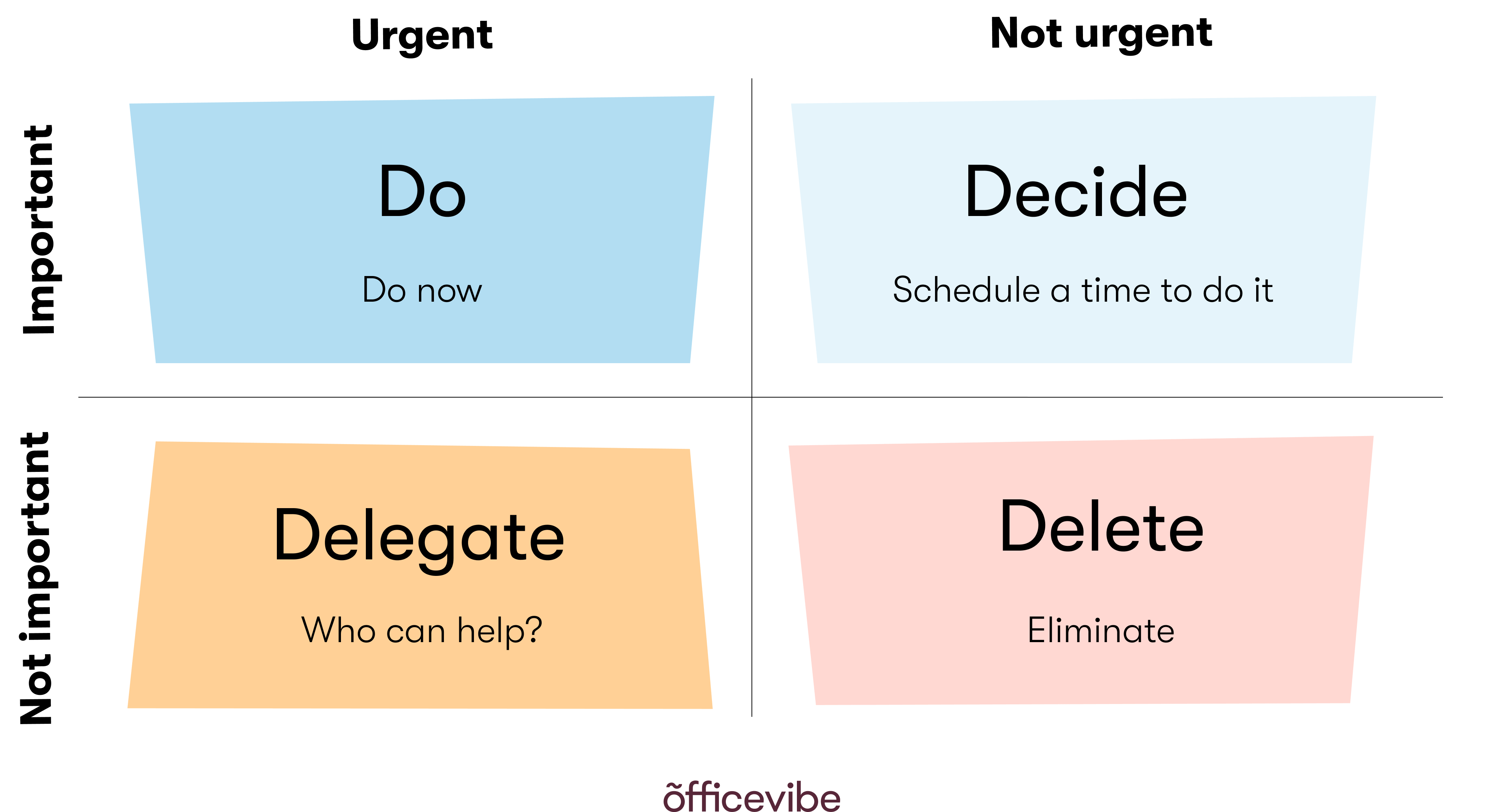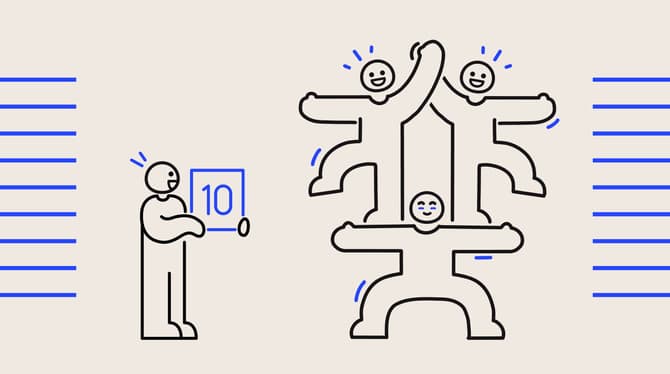The manager’s question of the hour:
“How do you manage to keep up with your busy agenda?”
This is a constant pain for managers. So, we went looking for a concrete answer on how to prioritize so you can be there for your team, and still get your own work done.
We gathered some testimonials and learned about the science behind productivity. We put it all together in a 5-rule method that, we are confident, will revolutionize the way you get things done for your work, your team, and your company.
Keep reading to learn how to prioritize, feel in control, anticipate, keep track of things, and know when urgent really means urgent.
Exclusive online summit
·
May 23 2024
Moments that matter: how to seed great work
In this article you'll learn
How productivity happens
If you want to have a prioritization system that works, you need to start by understanding how your brain processes tasks and helps you be productive.
We’ll explore the science of productivity. You’ll understand how a never-ending list of things affects you, why you feel like you’re never doing enough, and how you are not alone in your struggle.
Forget willpower
“On Monday I'll start my day with a to-do list.”
“Next time, I'll be better at gathering feedback.”
In his book “Will Power Doesn’t Work,” Benjamin Hardy explains why willpower doesn’t help you accomplish things. Willpower only considers your ability to push yourself to do something no matter what. What this mentality doesn’t take into account are the very real (and sometimes unexpected) external factors that affect how we feel and respond to life.
Don’t rely on willpower too much to get things done, push yourself to focus on important tasks, or to better your productivity. Instead, adopt methods that take you there, independently of how you feel or your lack of willpower.
Be aware of your instinct to procrastinate
Studies have shown that our brains have a tendency to avoid complex problems and move right away to simple, mindless tasks.
Before we start tasks or projects, our brain thinks ahead. It visualizes the hard parts and decides to focus on simple, mindless tasks that are easier to process.
If you want to get better at prioritizing, understand that your brain might organize things based on their complexity, and not necessarily their urgency or importance.
Have you ever felt overwhelmed even after crossing many things from your to-do list?
You’re not alone. This feeling might be caused by a concept called the Zeigarnik effect. Studies show that when the brain knows there are important unfinished tasks, it will keep them at the top of your mind until you get it done. This is why identifying urgent and important tasks from the rest of the pile is very important ― aka, proper prioritization
Being productive requires taking breaks
So you know what to prioritize but you still don’t manage to finish tasks. You might be missing focus times and breaks.
Breaks should be non-negotiable. This is because it is proven that breaks make you more productive.
Think about how runners approach marathons. They don’t sprint throughout the whole 42 km. They distribute their pace and energy. The same goes for professional musicians. They don’t practice all day, non-stop. They actually book 90 minutes-long practice sessions with breaks in between. Instead of extending their energy throughout the day, they focus and work hard, and then recharge.
Book time for hard tasks, and save break times in between. Don’t extend your energy throughout the day. Instead, run “sprints” of hard work and follow them with breaks.
If one thing is certain, it’s that we don’t know what tomorrow will hold. Make sure you recharge and have energy for what is to come. And proactively save the energy you’ll need for more complex work.
Multitasking will slow you down
Studies have shown that people who multitask, get less done. And that is because it causes you to work a little on everything, without actually completing much.
There will always be some multitasking that needs to be done but make sure that you set yourself limits, and when possible, focus on one thing. And that is where proper prioritizing comes in handy as well.
The 5 rules of how to prioritize
To develop our 5 rules, we dug deep into the research: reading academic research, sitting in on webinars, and just talking to other managers. Give our rules a try, see your productivity levels rise, and master your ability to prioritize.
1. Focus on what your team really needs
One of the best things you can do as a manager is to tackle and understand team issues before they grow into complex problems. This means having a system that allows you to be proactive and preventive when it comes to your team's wellbeing.
Knowing exactly your team's pain points is a real game-changer.
A tool like Officevibe automates diagnosis of your team’s wellbeing, regularly. Officevibe gives you full visibility on the right metrics to better understand your team. Having visual and quantitative metrics allows you to focus your management efforts on what is important, and prioritize what really needs your attention. And is all backed-up by science!

Another essential way to know where to focus will come directly from your team's feedback. So don’t wait too long to gather feedback. Keep a constant open door for people to communicate with you. So that you can prioritize issues that seem to be a constant across team members.
Officevibe opens a permanent window for regular employee feedback, so that you can gather impactful and anonymous feedback effortlessly and without worrying about it. Give it a try for free!
2. Have a tier system for your team’s work
Managers have two realities: their day-to-day work and their managerial role. Prioritizing these two spectrums properly will help you stay productive and in control.
On a webinar by Adobe’s Real Creative Leadership community, Chris Do and Adam Morgan recommended developing a tier system with your team to define work priorities. In action, this is how they do it:
- Tier 1: Is this a team priority to accomplish our goals? If yes, it is a Tier 1 task or project and will require the manager’s input and attention.
- Tier 2: Not a team priority but important? This would be a Tier 2. For their teams, this means it can be done in more than one way and could even be outsourced.
- Tier 3: Related to internal communications and inside work? This falls as Tier 3. As a team, they develop templates and guidance, but they let their team run the initiatives “on their own and deliver however they want.”
What is right for your team will depend on what you define as valuable and important.
Adam Morgan
When you have a tier system in place and your team members come to you with a new task, you’ll be able to get a lot of the context just by asking the Tier of the task. You’ll be able to confidently conclude if your involvement is needed, or encourage your team to believe in their capacities and be autonomous.
3. Use a prioritization system for your own work
We highly recommend the Eisenhower Decision Matrix. Unlike other methods, this priority quadrant method helps you reflect on what you can delegate and what to say no to. Which is key to your ability to be a productive and effective manager.

4. Practice trust
A key element to productivity is knowing when to delegate. When you’re a manager, you’re responsible for a group of people’s performance. And that is why without knowing, you might be doing more than you should. But, why is it so hard to delegate sometimes?
The answer often is a lack of trust.
The moments when I have been great at delegating is when things were so busy, I had to trust people to do their jobs and do it well. I didn’t have time to do otherwise. I was forced to remove myself from many instances. I quickly realized the power of allowing people to be autonomous and feel empowered.
Myles Carter, Content Manager at Sharegate
Practice trust and get comfortable with delegating, and you'll be bale to focus more on tasks that really need your managerial role.
5. Reflect and change your digital habits
In a LinkedIn post, Liz Willits, a well-known business owner and marketing influencer, shared her list to stay productive:
Productive People Do These 7 Things:
- Turn off Slack notifications.
- Turn off email notifications.
- Reply to emails and Slacks at scheduled times.
- Set phone to airplane mode.
- Use a productivity/focus tool. (I use Motion.)
- Eliminate 90% of meetings.
- Replace those meetings with email or Slack updates.
As the comments showed, this will look different to every manager. Not everyone can afford to turn off email notifications or eliminate meetings. But we can all reflect on the day-to-day activities that we’re caught up in, and which take lots of our time.
Deprioritize what you can, and eliminate what’s not helping you get things done (like meetings that could’ve been a well-written document).
Pro tip: You can take some of Liz’s advice and apply it for only some periods of your time (for example, turn off all notifications from 2-4 PM, or have no meetings on Tuesdays). Make sure you disclose this to your team so that everyone knows, and remain available for urgent matters.
You got this
Productivity and prioritization go hand in hand. For managers, it’s especially important since you're an employee with tasks and a manager at the same time. You manage up and manage down. Stick to our 5 rules and see the change almost instantly. You got this!
Equip HR and managers with tools to engage, recognize, and drive performance.




